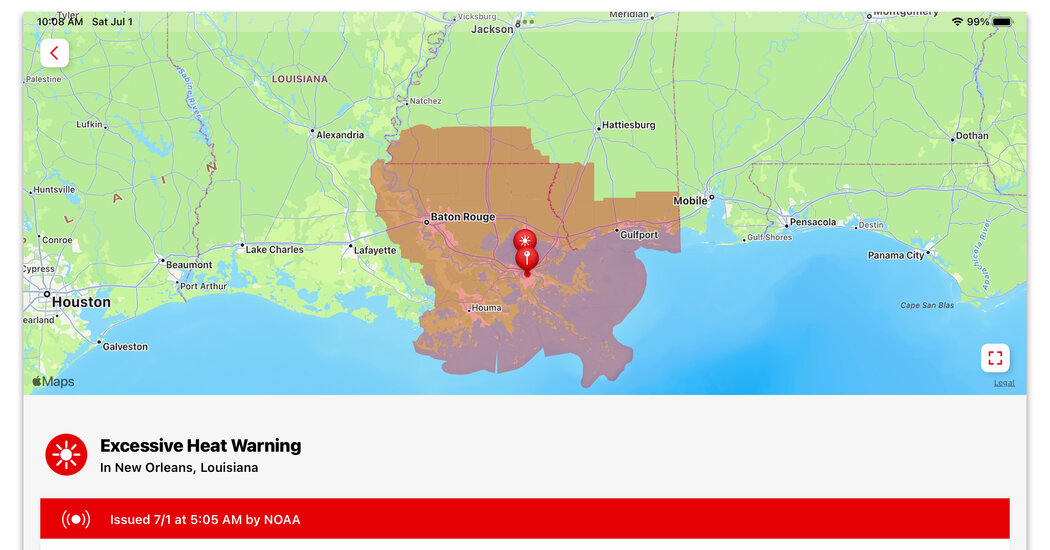Summer is in full swing now, but along with vacation trips, camp and lazy days, extreme weather has arrived for many parts of the country. If you live in an area that’s prone to such conditions, it helps to be ready. Here are some tips to help you use your tech through major meteorological moments — sometimes, even when power and cell service are shaky.
Stay Updated
Getting accurate local weather information helps you stay ahead of nearby threats like hurricanes, flash floods, tornadoes or wildfires. Setting up alerts on Apple’s default Weather app, the Google app or a specialized weather app keeps you notified. Bookmarking government web pages in your browser — like those for the National Oceanic and Atmospheric Administration, the National Hurricane Center or the U.S. Air Quality Index — is good for manual checks of current conditions.
Your phone can also receive wireless emergency alerts from authorized federal, state, local, tribal and territorial authorities. Check your notification settings to make sure these are enabled.
The American Red Cross also has a free Emergency app, which allows you to track 40 types of hazards, including earthquakes, tornadoes, extreme heat, hurricanes and wildfires — with alerts in English and Spanish. Emergency, which consolidates information from older Red Cross apps, also offers checklists, first-aid tips, information about nearby shelters and downloadable guides that work offline.
Stock Up
If the power goes out, you will need alternative ways to charge your phone — like a solar panel, a power cable for your car’s 12-volt dashboard outlet or a hand-cranked charger. Wirecutter, a product review site owned by The New York Times, has guides for alternative chargers, emergency radios and other equipment to help you through hurricanes, wildfires and earthquakes.
Stuff Your Digital Wallet
Losing your physical wallet in a catastrophe can be highly disruptive, but if you have credit or debit cards saved to the digital wallet app on your phone, you have a backup for businesses with contactless payment terminals. Digital versions of your health care cards and driver’s license may also be options. (Four states now offer official digital driver’s licenses or state ID cards for the Apple and Google wallet apps, but more are coming, including New York; some states also have their own digital ID apps.)
Just about every major insurance company has its own mobile app that you can use for filing a claim, getting roadside assistance and checking policy documents. If you have not installed your provider’s app and set up your account on your phone, do it before you need to use it.
And if you are mired in air-travel disruptions, your airline’s app helps with flight rebooking.
Make Cloud Copies
Sealed plastic boxes and fireproof chests can help protect vital documents and photos from the elements. However, digitizing the material — and storing it in the cloud on a secure server — gives you a virtual backup out of nature’s reach. Many multifunctional printers include a scanner, but you can also scan files reasonably well with a smartphone app.
Find Fuel
Big storms often disrupt gasoline delivery and other items on the supply chain. With its price maps and outage tracker features, the GasBuddy site and apps can help you find working gas stations.
As seen during the coronavirus pandemic, Google and Apple kept their maps apps updated with new information relevant to the situation like temporary business and road closures. And Google’s Crisis Response team has been working to provide flood forecasting, fire maps, hurricane warnings and other alerts to its software.
Know How to SOS
Apple’s iPhones, Google’s Pixel phones, Samsung’s Galaxy devices and other phones have shortcuts to call emergency services and pinpoint your location. Apple’s iPhone 14 models also include a satellite S.O.S. feature for when you are out of cellular range, and Google has a Personal Safety app for Android. Make sure you know how it all works on your model so you can get help fast if needed.
If you are stranded with a rapidly draining phone battery and no power, consider this common trick if you still have cell service: Change your voice mail greeting to state your location and situation. Even if your phone battery fades, loved ones trying to reach you will get the information.
Protect Your Phone
Of course, there may be situations so extreme that your phone is lost or damaged. Turning on the “find my phone” feature in your device’s settings before the bad weather arrives offers electronic hope for finding it later.
To recover faster from a destroyed phone, back it up online so its contents are safe and ready to download to a replacement device. Your phone manufacturer will be happy to sell you additional online storage space for a few dollars a month if you need it, but just make sure you have time to do a full cloud backup before those storm clouds hit.
J.D. Biersdorfer has been writing about consumer technology for The Times since 1998. She also creates the weekly interactive literary quiz for the Book Review and occasionally contributes reviews. More about J. D. Biersdorfer
Source: Read Full Article
